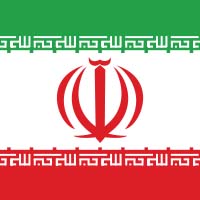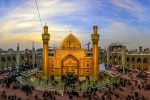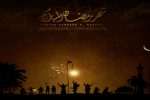The Imamate of Imam Musa Kazim (A.S.)
Whatever the Holy prophet has said about the Imamat, has already been mentioned in the previous chapters. Every Imam has mentioned about his successor. Just as Imam Ali Amirul Momeneen appointed Imam Hasan as his successor, Imam Hasan appointed Imam Husain, Imam Husain appointed Imam Zainul Abedin, Imam Zainul Abedin appointed Imam Muhammad Baqir, Imam […]

Whatever the Holy prophet has said about the Imamat, has already been mentioned in the previous chapters. Every Imam has mentioned about his successor. Just as Imam Ali Amirul Momeneen appointed Imam Hasan as his successor, Imam Hasan appointed Imam Husain, Imam Husain appointed Imam Zainul Abedin, Imam Zainul Abedin appointed Imam Muhammad Baqir, Imam Muhammad Baqir appointed Imam Ja’far Sadiq, Imam Ja’far Sadiq appointed Imam Musa Kazim , Imam Musa Kazim was appointed Imam during the lifetime of his father as subsequent proofs will testify.
Kirshi in his book ‘Rijaal’ mentions that the first person to hear of the appointment of Imam Musa Kazim was Faiz ibne Mukhtar.
Ibn Salit mentions that he with others went to pay their respects to Imam Ja’far Sadiq. Ibn Salit greeted the Imam and said, ‘May my parents be sacrificed upon you, O my beloved Imam, you are our purified Imam and no one who is born is immune from death, and we have come to ask you about your successor’. The Imam pointed towards his sons, and then he pointed towards his son Musa and said that he will be the leader of them all. In him is tact, science, charity and love for the Creator, and whatever difficulties that people come across in their religion, he has all the answers to them and will guide them to the straight path. He has the best possible way of treating people and a wonderful tact of talking to them, and he is one of the doors leading to God. Dawood Ibne Kasir asked Imam Ja’far Sadiq whom they would have to follow after him, to which the Imam replied that it would be his son Musa.
Once Imam Ja’far Sadiq openly proclaimed at a function that his son Musa would be the lawful Imam and rightful successor. At this function his sons Ali and Ishaq were also present and these two were termed as witnesses, and they were considered as learned divines. There were also present on the occasion, companions of Imam Ja’far Sadiq, and such other learned men whose knowledge of Islam was of a very high caliber and these were Muffazzul bin Oomer, Maazbin Kaseer, Abdulrehman bin Hajjaj, Faiz bin Mukhtar, Yakoob bin Sarraj, Imran bin Aayoon, Abu Baseer, Dawood-e-Rikkee, Yunus bin Zibyaan, Yazid bin Salit, Suleman bin Khaled, Safwanay Jammal. All of them were made to bear witnesses to the statement of Imam Ja’far Sadiq, regarding the Imamt of Imam Musa Kazim. Ebrahim-e-Karkhi has mentioned that one day he went to Imam Ja’far Sadiq and whilst he was conversing with the Imam, his child Musa happened to come before them. He kissed the child and the Imam informed them “that after me, my son Musa will be your Imam.” “People will become his enemies and trouble him. But his enemies will suffer and may the wrath of Allah be on these murderers, and God will increase their punishment.” Then the Imam informed me that after Imam Musa Kazim, his son Imam Ali Reza would be the Imam.
Walid bin Sabin narrates that he heard from Abdul Jaleel that Imam Ja’far Sadiq had made Hazrat Ismail his Successor. “I approached the Imam for clarification whether three years back he had proclaimed Hazrat Ismail as his successor” Then Imam at once replied on oath, that he had never said it and he further said the he named Imam Musa Kazim as his successor.
Obaid Ibne Zorara narrates that the Holy Imam Ja’far Sadiq said “that it is Satan that comes in the form of Janab Ismail and deceives the people. It is absolutely certain that Satan can never appear in the form of a Prophet or an Imam. Now whoever says that my son Ismail is not dead but alive, it can be taken for granted that it is Satan appearing in the shape of Janab Ismail.”
Then the Imam informed me that the Imamat is in the hands of God and HE will choose whomsoever He wants. So God chose my son Musa as Imam, and Satan can never come in the likeness of Imam Musa and I praise the Lord for it. From this it is clear that Satan appeared in the likeness of Jaban Ismail to deceive the people and create confusion, and it is also mentioned that Satan appeared in his garb even when he (Janab Ismail) was alive.
Kulaini in Furoo-e-Kafi mentions the followings Janab Ismail had in his possession some Dirhams (currency of the place) and he decided to invest this amount with a businessman proceeding to Yemen for a share in a venture. Janab Ismail mentioned this to his father and the Imam informed him that the man was drunkard and to give him money for business or to have anything to do with him was very wrong. Inspite of this advice, Ismail entrusted the amount to this stranger, who swindled him, and the money was lost. Imam Ja’far Sadiq and Janab Ismail proceeded for the Haj Pilgrimage, and the Imam heard him supplicating to God to have his money returned. The Imam informed him that God would never listen to his request since he went against the wishes of the Imam.
The Death of Hazrat Ismail
Hazrat Ismail was the eldest son of Imam Ja’far Sadiq, and when he was 28 years old, his brother Imam Musa Kazim was born. In these 28 years, people began to feel that Hazrat Ismail would be the successor as they knew that the Imam loved him very much. This talk spread far and wide, and it was now left to Imam Ja’far Sadiq to make it known to the world who his successor would be. Both Sunni and Shia authorities are unanimous in their verdict that Hazrat Ismail died during the lifetime of his father, Imam Ja’far Sadiq.
Saddrudin Hanafi-e-Kadri in his book ‘Kitab Rawa-e-Hool Mustafa’ mentions that Hazrat Ismail died during the lifetime of his father Imam Ja’far Sadiq in Urez, and his body was taken to Medina for burial.
As soon as the soul left the body, Imam Ja’far Sadiq closed the eyes of Hazrat Ismail with his own hands and kissed his face. Then he ordered that the body should be given the purification bath, and finally when the shroud was put on the body, Imam Ja’far Sadiq wrote the following inscription along with the name of Hazrat Ismail ‘Ismailo Yash hado an lailaha illalla.’ I bear witness that there is no God but Allah.’
After the death of Hazrat Ismail, Imam Ja’far Sadiq did his best to spread the news of his death so that no one should think him to be Imam, and people should not be misled.
Dawood bin Kaseeray Rikkee, Himran bin Aamoon, Abu Basheer, Muffazzal ibne Oomer and 30 of his near and dear companions were asked by the Imam to uncover the face of Hazrat Ismail and ascertain whether he was dead or not. Dawood confirmed that Hazrat Ismail was dead and all the rest were told to be witnesses. Then Imam Ja’far Sadiq prayed, O Allah, you bear witness to this.’
After the purification bath, Imam Ja’far Sadiq asked Muffazzal to verify once again by looking at the face of Hazrat Ismail. Muffazzal after seeing the face confirmed that Hazrat Ismail was dead and there could be not doubt whatsoever. All those present were asked t bear witness, for Imam Ja’far Sadiq knew very well the controversy that would arise from this. Once again he asked God to bear witness and then the coffin was finally closed and taken towards Medina.
The Imam removed his gown (Aba) as a sign of his grief. At various places the cortege halted and the face of Hazrat Ismail was shown to the people as a proof of his death. This was especially done to make known to everyone that Hazrat Ismail was truly dead, and that he died during the life-time of his father who was the Imam. In spite of all these precautions, some people in distant lands could not reconcile themselves to the thought of Hazrat Ismail’s death.
The funeral reached Medina and Hazrat Ismail was about to be buried in the grave prepared for him. Once again Imam Ja’far Sadiq asked Muffazzal to look at the face of Hazrat Ismail and confirm whether he was dead or alive, and to identify him. All replied, ‘O friend of Allah, there is no doubt whatsoever that Hazrat Ismail is dead.’ Once again Imam Ja’far Sadiq said, ‘O Allah you bear witness to this’. The Imam then warned that the mischief makers amongst the people would try to create confusion.
‘Youreedoona lay-yootbay-o Noorallahay. People would try to extinguish the Light of Allah.’ Chp 61 8.
Then Imam Ja’far Sadiq turned towards his son Musa and said ‘Wallaho Muttimmo Nooreyhee, Walau Karehal Kafeyroon. God will see the Light is not extinguished and let the unbelievers feel hurt at their lost.’ Chp. 61 8.
Then the coffin was lowered in the grave and filled with earth. After this the Imam asked the people who attended the burial as to who the deceased was and they replied that it was the Imam’s son Ismail. Again the Imam said, ‘O Allah you bear witness.’ After the burial, Imam Ja’far Sadiq stood near the grave and prayed to God, ‘O Allah if Ismail has failed to do anything for me then I forgive him, and if You have found him wanting in Your way, then forgive him for my sake.’
Then Imam Ja’far Sadiq held his son Musa’s hand and said, ‘Howa haqqoon wal haqqomah, wa min ila an yeareysallah al arzey wa man alaiha.’ This is truth and truth is with him and through him the truth will be known till then end.’ Then he returned home and spoke to his companions about the treachery in this world.
There is no dispute about where Hazrat Ismail is buried. He is buried in Medina. Kitab-e-Muntahal Aamaal quotes that Syed Zaamin Sadkam mentions in his book Taufatul Azhar, that Hazrat Ismail is buried in the house of Zaidus Saeed, the son of Imam Zainul Abedin at Medina. A small mausoleum was built on the grace by Husain ibne Abil Hamza, the minister of the Caliph Obaid Ali in 546 A.H.
Ja’far took great pains to see that the death was properly authenticated. The body lay in state in the house for three days where people might see it. When people came to express their sympathy with him, the Imam had them sign a statement which he had drawn up. “He did this until in Medina all the Hashimites, local people and visitors had given their signatures.” At the grave, in the Baqi’ cemetery, the signature of the Governor was also secured.
Ismail’s death is even more mysterious than his life. The Ithna Asharis, Sunnis, and Orientalists seem to agree that Ismail predeceased his father. However, some Ismailis disagree and have some interesting theories regarding the death of Ismail. Even the Ismaili scholar Daftary comments, but most sources relate that he (Ismail) died before his father (A Brief History of Ismailism, 33). As mentioned previously, the original Mubarikiyya sect and the smaller sect that emerged from it after it split upheld the notion that Ismail did predecease his father and was Imam during his father’s life. Other Ismailis believe that the funeral of Ismail was a mere ruse in order to trick the Abbassids into assuming that Ismail was dead and no longer a threat to their caliphate. According to Ismailis, the performance of a false funeral was justifiable because Imam Sadiq (AS) was applying the principle of taqiyya.
Some of them (followers of Ismail) say that he did not die, but that his father had declared that he had died to save him from the Abbasid caliphate, and that he had held a funeral assembly to which Mansur’s governor in Medina was made a witness (Sadiq Ali, 142). Another theory espoused by Sadiq Ali is that the identity of the deceased was not Ismail but was his twin brother, Abdullah. Imam Sadiq (AS) remained silent when people assumed that the identity of the deceased was Ismail. Also, Ismail was stealthily sent out of Medina that night. Later, Ismail adopted the name of Abdullah. Sadiq Ali draws the following conclusions It (book called Asraru’n-Nutaqa) further relates that both Abdullah and Ismail almost resembled each other physically, and none among those present could perceive the death of Abdullah due to an alikeness among the identical twins and therefore, the death was considered that of Ismail. On that juncture, Ja’far Sadiq was constrained to remain silent, since the Abbasids had conspired to kill Ismail and therefore, it became a mystery, making Ismail publicly dead during his father’s time, but in reality he was not dead (Sadiq Ali, 143).
The issue of whether or not Ismail passed away during the lifetime of his father is central to the debate behind the succession to Imam Sadiq (AS). Another central question to the debate regarding the succession to Imam Sadiq (AS) is whether or not a change of nass occurred. Ithna Asharis claim that there was a change of nass decreed by Allah (SWT). Initially, Imam Sadiq (AS) had designated that Ismail would be his successor. However, supposedly, Allah (SWT) revealed to Imam Sadiq (AS) that Imam Musa Kazim (AS) should replace Ismail as the successor of Imam Sadiq (AS). The Ismailis argue that the hadith about the change of nass is fabricated. Also, the Ismailis believe that Allah (SWT) would not change a decree on the designation of Imammate. They quote the following hadith
Verily, God makes changes in everything except in the matter of Imam (Sadiq Ali, 148). Also, some Ismailis claim that the Imams know the unseen and the future. Since they have the knowledge of the unseen, the declaration of the change of nass would imply that the Imam is deficient in his capabilities. Sadiq Ali quotes Sachedina from Islamic Messianism, ‘It implied God’s change of mind (bada) because of a new consideration, caused by the death of Ismail. However, such connotations in the doctrine of bada raised serious questions about the nature of God’s knowledge, and indirectly, about the ability of the Imams to prophecy future occurrences (Sadiq Ali, 148). The Ithna Asharis maintain that the Imams have knowledge of some aspects of the unseen; but, certain abrogation can be made in injunctions which is a reflection of the Divine Will. The issue of the change of nass is vital to the discussion about the succession to Imam Sadiq (AS).
In order to maintain legitimacy in the face of criticisms from the Ithna Asharis, the Ismailis also have various refutations of the Ithna Ashari doctrines. The Ismailis ridicule the Ithna Asharis’ view on Imam Mahdi (AS). The Ithna , Asharis believe that their twelfth , Imam, Imam Mahdi (AS), did not pass away and remains in occultation till the present day and will return to the Earth’s physical plane before the Day of Judgement. In Haft Bab, an early Ismaili text that was written more than five hundred years ago, the author contends that no human being can have such a large lifespan. And, every intelligent man knows that no human being can live for five hundred years, and cannot therefore remain all that time hidden in a cave (Haft Bab, 15). The Ithna Asharis might argue that Prophet Nuh (AS) also lived for one thousand years, that Prophet Khidr’s lifetime spanned a great deal of time, and the Sleepers of the Cave also lived beyond their average lifespan. To this argument the author of Haft Bab replies, We would say to this that all such stories require tawil (esoteric interpretation), and they must be used (only) in their implied sense
(Haft Bab, 16). Also, the Ismailis claim that the general public would remain bereft of knowledge under an Imam who they cannot contact. The Ithna Asharis might reply to this argument by quoting a hadith by Imam Sadiq (AS) that equates the awaited Mahdi (AS) to the sun behind the clouds which constantly bestows light to the people. Since, the Ismailis do not accept the concept of the Mahdi (AS), they consider the line of Ithna Ashari Imams to have ended at Imam Hasan al-Askari (AS), the father of Imam Madhi (AS). Sadiq Ali quotes Ivanow as saying, ‘If an Imam dies without leaving a son as his successor, it can only mean that not only he personally, but the whole line of his ancestors were not the true Imams. Thus the discontinuation of the line of the Twelvers proved that at least the last several of them were not genuine’ (Sadiq Ali, 153). These are some of the arguments between the Ithna Asharis and the Ismailis. The early Ismailis shared some similar doctrines. They believed that Quran and sharia have a zahir or exoteric and batin or esoteric dimension. The rules within the sharia are the exoteric aspect and are followed by only the common people. However, the khawass or elite follow the esoteric aspect of the sharia which is extracted from the tawil or esoteric aspects of the Quran. There are some Ismailis today, the Nizaris, that do not follow the shariat in minute detail. The author of Haft Bab explains, Those persons who have stuck in the world of shariat and have not reached the haqiqat are described in the Coran as ‘dead, not living. The people who follow sharia only are dead because they are not under the orders of the Bearer of the Truth of the time (Haft Bab-I Bu Ishaq, 19).
The Last Advice of Imam Ja’far Sadiq
Because of the great danger to the life of his son Musa Kazim, Imam Ja’far Sadiq used a stratagem. He gave firstly the name of the Caliph Mansoor, secondly the Governor of the Caliph at Medina, thirdly the Imam’s son Abdulla Aftab, and fourthly the Imam’s wife Hamidah Khatoon (the mother of Imam Musa Kazim) and finally the name of his son Musa. Firstly, the murderers of Imam Ja’far Sadiq (namely the Caliph and the Governor) could not be Imams. Then Abdulla Aftah had an inherent defect and could not be one, and finally, a woman could not be an Imam. So finally there was only Imam Musa Kazim left. When the followers of Imam Ja’far Sadiq heard these names they were happy and understood the situation and said that the Truth has been disclosed.
The Writings of Sunni Scholars on the Imamate of Imam Musa Kazim and his Splendour
Sadruddin-e-Hanafi Kadri in ‘Kitab-e-Rawa-e-hool Mustafa,’ mentions what many a Sunni Aalim has said about Imam Musa Kazim.
In Kitabey Rauzatul Ahbab and Sawaahaydoon Nabooway and Taarikay ibne Khallaykan it is mentioned that Imam Musa Kazim was the seventh of the twelve Imams and his titles are Kazim, Abdus Saleh, Saabir Saleh, Zainul Mujtahaydeen, and the period of his Imamate was 35 years. Shaikh Abdul Haq Dehalvi (Hanafi) says in Sher-e-Miskat, that Imam Shafei has said that the Tomb of Imam Musa Kazim has become a sanctified place for the fulfillment of one’s wishes and his wonderful knowledge and dealings with people clearly showed that he was pious, virtuous and endowed with knowledge from the Holy Prophet. In his speech he never hurt anyone and whatever he said no one could dispute or challenge.
Ibne Khallakan says that Khateb-e Bhagdadee has said that Imam Musa was known as the Righteous because of his prayers and supplications; he was well known as Kazim, and he set about his way in such an humble manner, that he even forgave his enemies. In ‘Sawaaykul Moreka’ Ibne Hazar-e-Hanafi mentions that Imam Musa Kazim was the natural successor of Imam Ja’far Sadiq in knowledge of religion, in his behavior towards the people, and in his miracles; his knowledge was beyond the bounds of ordinary mortals and as he used to restrain his temper and forgive people he was called Kazim; the people of Iraq used to take his name as intercessor to God, and get their supplications granted. He was the greatest religious authority of his times and greatest giver of charity.
Yaafeyee Yemani, in his book ‘Miraatool Jinnan’, mentions that Imam Musa Kazim was pious, charitable, virtuous and a person commanding great respect and was known as Abdus Saleh. He was one of the Twelve Imams, who spent his time in fervent prayer.
In the book ‘Rauzatoos Safa,’ Mamoon Rashid has mentioned that he had heard form his father Haroon Rashid, that Imam Musa was the Imam, and the Imam of his time and the Caliph for everyone. “And I (Haroon Rashid) am the Imam for oppression and injustice and still I am the Imam of my time, and I swear on God, that Imam Musa is the rightful heir to the Holy Prophet. I admit that I do not care for the good of my people and I am heartless and cruel. I swear on God, that if my son were to oppose me, I would tear out his eyes, for according to me I will not tolerate any opposition and interference in the sate.” Further adds Haroon Rashid, “that this Musa Kazim is the Successor of the Holy Prophet of Islam and if anyone wants to have the knowledge of Islam, he should go to the Imam Musa Kazim.” When I heard these words from my father, Mamoon says that the love of the Ahl-ul-Bait became firm in my heart and felt that they (the Ahl-ul-Bait) should be respected and given the great importance that they deserve and under no circumstances should they be troubled.
Shaikh Abdulla bin Mohammad bin Aamir Sibraawee Shafei, in his book Ittayhaf bay Hoobbil Asraaf (Egypt) mentions that Imam Musa Kazim was the seventh of the Imams.
The Religious Knowledge of Imam Musa Kazim
The knowledge of Imam Musa Kazim connects with that of the Holy Prophet, who had his knowledge direct from God. Hence it is very clear that even in his infancy the Imam’s knowledge was outstanding.
Yakoob Sarraj mentions that one day he had been to visit Imam Ja’far Sadiq at his residence and noticed that the Imam was standing near the cradle of his son Musa and was talking to him in confidence, I waited till the Imam was free and then I sat near him as instructed. Imam Ja’far then asked me to greet his successor Imam Musa Kazim. I did so, and to my surprise the infant clearly reciprocated to my greetings, and informed me that I should go back home and change the name of my daughter, whom I had named Humeara, as the name was not pleasing to God. Imam Ja’far told me to do exactly what his son had said, so that the result would be good. I went home and changed the child’s name.”
Once Abu Hanifa went to see Imam Ja’far Sadiq in Medina. A young child of about 5 years was also with the Imam, and Abu Hanifa inquired of the Imam who the young child was! The Imam replied that he was his son Musa. Abu Hanifa asked the child, ‘Who sins’ The child asked Abu Hanifa to sit down. He told Abu Hanifa that sin could be from God or from man or from both. But God cannot sin, for he is Aadil (Just) and can never do injustice. If the human being is not guilty it is not possible for God to punish him. Now if both God and man sin then God is a partner in this; again this is not possible. Hence it clearly points to the human being who is responsible for his actions. Hence the idea of ‘reward and punishment’ and ‘Heaven and Hell’. When Abu Hanifa heard this he recited the following verse of the Quran “Zoorreeyatan bazoha min baz. Wallaho samee-oon aleem.” Meaning “Offspring, one from the other; and verily God is All-Hearing; All-Knowing.” Chp. 333. This ayat is a pointer to the Holy Ahl-ul-Bait.
Abu Hanifa visited Imam Ja’far Sadiq and said that he had seen his son Musa saying his prayers and had noticed people passing to and fro in front of him. Imam Ja’far sent for his son Musa, and told him what Abu Hanifa had said. Janab Musa replied that it was true. Then he said, ‘O dear father, the Person before whom I am offering namaz is nearer to me than my jugular vein.’ Then he recited the following verse of the Holy Quran ‘Wa Nahnoak akrabo eelaihay min hablil warid’. Imam Ja’far lifted him in his arms and kissed him and said, ‘my parents be sacrified for you, and ‘God is the Knower of all things.’
Ali ibne Rashid and other tradition writers mention that the Shias of Naishapur gather together and made Mohammad Bin Ali their deputy to go and give Imam Musa Kazim 30000 Dinars, 50000 Dirhams and 2000 pieces of clothes. A lady by the name of Shatita gave to this deputy on her behalf to give to the Imam a knitted piece worth 4 Dirhams and a 1 Dirham coin and she told Muhammad bin Ali ‘Innallah la yestahee minal haqqay’, meaning Allah is proud of the Truth (Haq) even if the amount be small.’ A bag was given containing 70 letters with a request for some religious clarifications and an empty bag was given for bringing back replies. Each envelope was tied with a string and sealed.
He was instructed to take the envelopes in the night to the Imam and collect them the following morning. He was asked to open five letters to see whether the Imam had replied to the queries. If he had replied to these letters then he was the true Imam and the money and clothes should be given to him, or else to bring back everything that he had taken.
When Muhammad Bin Ali reached Medina, people asked him to go to Abdulla Atfah. He went to Abdulla and when he returned from there he was very dejected and said, ‘Where to go. ‘Shall I go to a Jew or shall I go to a Christian,’ and said, ‘O Allah show me the way to the right path-guide me, O Allah.’ I was standing in this confusion, when a slave approached me and said that he would take me to the one whom I wanted to see. So saying he took me to Imam Musa Kazim. When the Imam saw me, and although he had never seen me before, addressed me as Abu Ja’far, and asked me why I was so sad and dejected over not finding him and why I desired to go to the homes of the Jews and Christians ‘Come, I will make you comfortable and relieve you of your worries.
I am the representative of God on this earth and the friend of God. Did not Abu Hamza guide you when you were waiting outside the mosque of our beloved Prophet I have already answered all your questions yesterday.’ Then the Imam asked for the bag in which was kept the Dirham belonging to Shatita which was correct in weight, which I had kept in the same bag containing the other Dirhams.
The Imam also requested for the knitted piece given by Shatita, which was kept in the bag with the other clothes sent for him.
Muhammad Bin Ali said, “When I heard this I was amazed and astonished, and handed over the knitted piece and the Dirham given by Shatita to him. I did exactly as instructed by the Imam and when he had the knitted piece and Dirham in his hands he turned towards me, and recited the same verse as Shatita ‘Innallaha la yestahee minal haqqay’. Then he said, ‘O Abu Ja’far, convey my salaams to Shatita, and give her this bag containing 40 Dirhams; then the Imam gave me a piece of coffin cloth and asked me to tell Shatita that my sister Halima has worked on it and the thread used in it is from my grand mother Fatima, the daughter of the Holy Prophet.”
The Imam said, “Tell Shatita that 19 days after she gets the coffin cloth, she will die and tell her to use 16 Dirhams out of the forty sent to her, on her own requirements, but she must give the balance of 24 Dirhams as her own offering to the poor, and I will be present at her funeral, to recite the burial prayers Abu Ja’far it is better for you to keep all this secret. The amounts which you have brought for me, may please be returned to their respective owners and then open the seals of the envelopes to see if they have been answered or not.” When Muhammad bin Ali returned home, he noticed that the seals on the envelopes were intact. He broke open one seal to see whether it was replied and he was surprised to find that inspite of the seal being intact the letter was answered. Then he opened another seal and surprising enough the reply had also been given. He checked up on yet another cover and found the same. He was no more surprised because he now had full faith in the Imam.
When Muhammad bin Ali reached Naishapur, he returned all the things he had brought back, and noticed that all those who had given money and clothes for the Imam Musa Kazim had joined hands with Abdulla Aftah. No wonder Imam Musa Kazim had returned what these people had send and retained that of Shatita. When he met Shatita, he noticed that she was firm in her faith and informed her what the Imam had said. Shatita expired on the day predicted, and the Imam was seen arriving on a camel to perform the funeral prayers. Before leaving, the Imam sent greetings to his followers, and urged them to be God fearing and righteous, and the Imam would also be present at their funeral prayers.
The Miracles of Imam Musa Kazim
The miracles of Imam Musa Kazim have been mentioned by many learned divines of the Sunni Community.
Shaikh Abdullah ibn Muhammad Aamayree Sibraawee Shafei in his book ‘Ittayhaf,’ mentions that when Imam Musa Kazim was in prison during the time of Caliph Haroon al Rashid, Kazi Abu Yusuf and Muhammad ibn Hasan Shaybani (Both learned divines of the Sunni community and followers of Abu Hanifa) visited the Imam at night to ask him about some urgent problems. The guard of the prison came to the Imam and told him that as his duty was over, he was going home and would return the next day. Then before leaving, he asked the Imam if he had any work which needed to be done. The Imam answered in the negative and the guard departed.
After the guard left, the Imam told his guests that the guard would die tonight. They were shocked to hear this and in the excitement forgot to clarify their problems, and left the prison. On the way they were saying there was no doubt that the Imam knew the hidden secrets, but to verify this statement they deputed someone to go to the guard’s house and wait outside to find out the truth of the Imam’s statement. In the middle of the night, the person who was sent to watch, heard the sound of crying, and upon making inquiries, he was informed that the prison guard had died. He returned to Kazi Abu Yusuf who had sent him, and informed him of this. All were wonder-struck and fully realized the powers of the Imam.
Sadruddin Hanafi Kadri in his book, ‘Rawaayhool Mustafa’ mentions from ‘Rauzatool Ahbab’ that Badrey, a slave of Imam Ali Reza narrates the following incident ‘Once Ishaq Ibne Amman was present in the company of Imam Musa Kazim, when a person from Korashan came and sat down in the congregation. This person spoke to the Imam in a language unknown to anyone else. The Holy Imam spoke to the stranger in the same dialect. Ishaq was wondering what language this could be and asked the Imam for some clarification. He was informed that this was spoken in Tibet and China. Ishaq told the Imam that since you have always been in this part of the world, how is it that you know the dialect of a place which you have never visited. The Imam told him there is no speech unknown to one who is real Imam and whose appointment was made by God and the Holy Prophet. Even the language of birds, animals and fish is known to us!
Sadruddin Hanafi, in his book, Rewa-e-Hool Mustafa, mentions that after the death of Imam Ja’far Sadiq, in complete disregard for the instructions left behind, Abdulla Aftah, one of his sons, proclaimed himself as Imam.
Imam Musa Kazim, who had been appointed as Imam by his father Imam Ja’far Sadiq, had ordered a bundle of firewood to his house, and send his brother Abdulla Aftah who posed as the Imam. He lighted the wood, and the fire started to burn. Imam Musa Kazim stood up and with his clothes walked into the fire and sat in it, and from there he talked to the people who were his guests. Then he came out from the fire and dusted the ash from his clothes and turned towards Abdulla and told him that since he was making claims on the Imamat, he should not be afraid to walk into the fire. Abdulla the imposter was so frightened that he quickly walked out from the Imam’s house.
It is necessary to know the Imam of the time
Appointment of Imam is based on Divine command
An Imam is born as such but he attains Imamate only upon the passing away of his predecessor.
Nass in favour of Imam Musa Kazim (a.s.) is proved from both Shia as well as Sunni books The life and character of Imam Musa Kazim (a.s.) matches with that of Imam Sadiq (a.s.) and the other preceding Imams.
A brief description of 8th to 12th Imams (a.s.) to show they matched perfectly with their predecessors.
Source: www.alhassanain.org/english
این مطلب بدون برچسب می باشد.










Leave a Reply